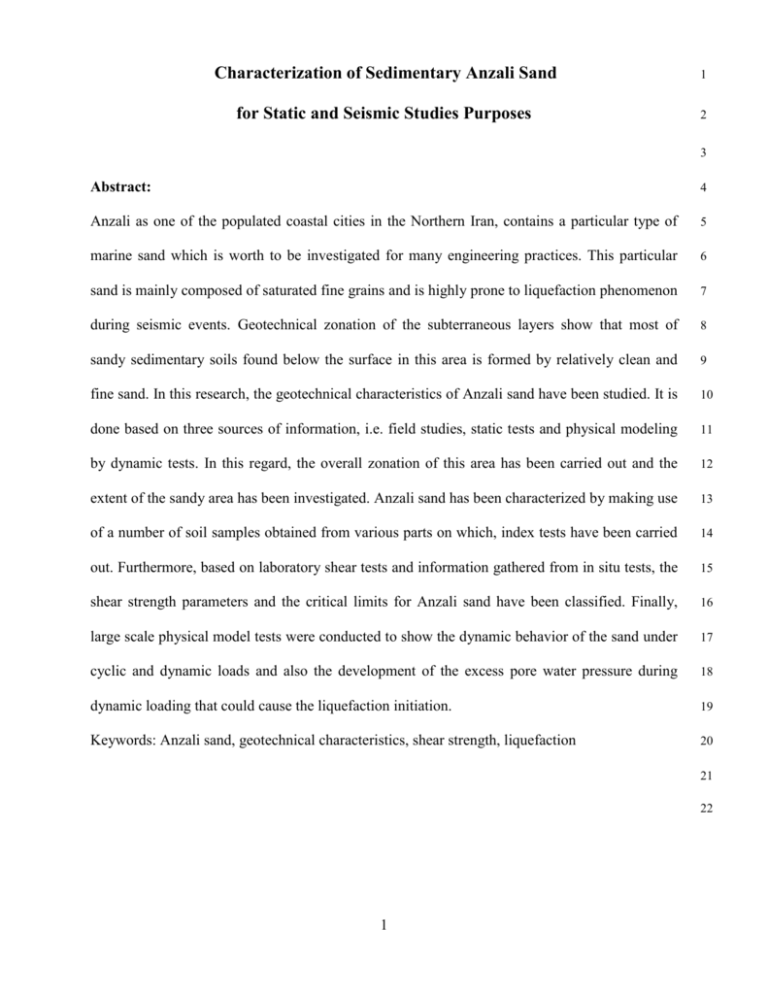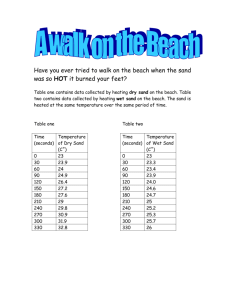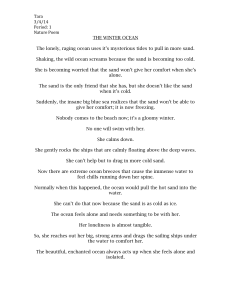Characterization of Sedimentary Anzali Sand for Static and Seismic
advertisement

Characterization of Sedimentary Anzali Sand 1 for Static and Seismic Studies Purposes 2 3 Abstract: 4 Anzali as one of the populated coastal cities in the Northern Iran, contains a particular type of 5 marine sand which is worth to be investigated for many engineering practices. This particular 6 sand is mainly composed of saturated fine grains and is highly prone to liquefaction phenomenon 7 during seismic events. Geotechnical zonation of the subterraneous layers show that most of 8 sandy sedimentary soils found below the surface in this area is formed by relatively clean and 9 fine sand. In this research, the geotechnical characteristics of Anzali sand have been studied. It is 10 done based on three sources of information, i.e. field studies, static tests and physical modeling 11 by dynamic tests. In this regard, the overall zonation of this area has been carried out and the 12 extent of the sandy area has been investigated. Anzali sand has been characterized by making use 13 of a number of soil samples obtained from various parts on which, index tests have been carried 14 out. Furthermore, based on laboratory shear tests and information gathered from in situ tests, the 15 shear strength parameters and the critical limits for Anzali sand have been classified. Finally, 16 large scale physical model tests were conducted to show the dynamic behavior of the sand under 17 cyclic and dynamic loads and also the development of the excess pore water pressure during 18 dynamic loading that could cause the liquefaction initiation. 19 Keywords: Anzali sand, geotechnical characteristics, shear strength, liquefaction 20 21 22 1 1. Introduction 23 Anzali port in Guilan province, located in 49º 28' 00" West and 37º 27' 30" North, is part of the 24 Caspian Plain. Anzali sand is a particular type of sand found near the Caspian Sea, in the 25 Northern Iran and covers a narrow strip along the coastal line. It is found that the level of ancient 26 lakes affects on the type of sediments and their grain size distribution (e.g. Xiao et al. 2013). 27 Several investigations have been made on Anzali sand revealing many different parameters 28 including static and dynamic soil parameters (Fattahzadeh, 2005; Asefi et al., 2009; Hasani, 29 2009; Ghorbani et al., 2013, Ahmadi et al., 2014). It is found that the main characteristics of 30 different soil layers in this area are often dominated by this type of sand. Anzali sand is mainly a 31 fine sand with some silt contents. Geographical location of the area under study is shown in 32 Figure 1. Caspian Sea is structurally formed by folded geological units with a trend parallel to its 33 coast line. The beach itself covers entirely by Anzali Sand. Coastal sands are classified into 34 alluvial sand or water-transported particles. Thus, coarse particles are very rarely found in this 35 sand in comparison to other types of sand. 36 The Caspian Sea is a narrow coastal strip and there is no mule due to intangible tide. Basically in 37 most sandy beaches, such as the Caspian Sea coast, the sea waves are broken before they reach 38 the shoreline. Breaking waves release most of energy caused by massive forces pushing them 39 forward. The pressures due to released force take coastal sands out and drive them onto 40 mainland. When the waves are reflected, a portion of the sea-sands are returned to the sea and 41 this portion depends on the grains size of the sand. In this process however, some portion of the 42 sand will always remain out of the water. This mechanism gradually drives the sand out from the 43 sea water and makes dunes or sand walls of several decimeters. There are scattered sand dunes 44 from Guilan to Gorgan, another area in the Northern Iran (and also the name of a city) in the 45 Southeastern Caspian Sea (Talebi, 1998; Jackson et al., 2002; Brunet et al., 2003; Ranjbar, 46 2012). 47 2 48 2. Geotechnical Zoning and Field Tests 49 Many coastal areas of Anzali port are composed of uniform fine sand. Geotechnical studies 50 which have been performed down to several meters in many parts, confirmed this property of 51 Anzali Sand. The sands are generally uniform, and composed of fine and very fine-grained 52 particles with loose to medium density indices. 53 Fattahzadeh (2005) studied the characteristics of the soil in this area by data collection among 75 54 boreholes to a maximum depth of 23 meters at three different zones in Anzali. The zones 55 include: a) 25 boreholes in Lijarki - Koliver axis (Lijarki is located in the east and Koliver is 56 located in the Southwest of Anzali); b) 30 boreholes in Anzali-Kapourchal route (Kapourchal is 57 located in the west of Anzali port) and c) 20 boreholes in Hasanroud-Setare Shomal (Hassanroud 58 is located in the southeast of Anzali). On this account, in Lijarki - Koliver route, subsurface 59 layers to a depth of 10m are composed of fine sands with some amount of silt and often 60 categorized into SP, SM, and SP-SM classifications according to the Unified Soil Classification 61 System (Table 1). A graphical representation of the soil properties with depth observed in four 62 boreholes is shown in Figure 2. In addition, variations of SPT blowcounts are also shown in 63 Figure 3 which illustrates the range of SPT blowcounts with depth observed in different 64 boreholes. Also, at some boreholes interlayers of clay or silt soils have been observed with a 65 maximum thickness of 4m. By moving from the Lijarki region towards Koliver, the amount of 66 fine particles decreases and the portion of the coarse aggregates is grown. SPT blowcounts were 67 generally found to be between 5 and 30 in these layers, which indicates that the layer density 68 indices are low to medium. Moreover, there are sublayers of loose sands in some of the 69 boreholes to a depth of approximately 6 meters. In Anzali-Kapourchal route poorly graded sand 70 had been found with some silt. In Kapourchal region, the thickness and the density of sand layers 71 are reduced. At Hassanroud axis toward the Setare-Shomal (Anzali free zone), the fine sand with 72 3 some silt can be generally observed in surface soils and at depths of 5 to 10 meters, there are 73 clayey soil sublayers. In addition, the data of 30 boreholes drilled by geotechnical consultants in 74 Northwest of Anzali have been collected and 20 additional boreholes have been collected in 75 different regions. This indicated many layers of subsurface soils consist of uniform fine sands 76 which are classified into poorly graded sand. In these boreholes, SPT blowcounts are between 10 77 and 30 blows for sand layers that indicate these layers are of low to medium density indices. 78 Although in some boreholes, higher blowcounts up to 40 blows, were observed indicating a 79 dense soil layer. 80 81 3. Index Parameters of Anzali Sand 82 To evaluate the index parameters of Anzali sand, six soil samples from different locations of 83 Anzali were selected at different depths. Grain size distributions of the soil samples for six types 84 of sand, namely S1 to S6, were measured according to ASTM D-422 which are shown in Figure 85 4. Results of particle-size distribution of soils obtained in sieve analysis revealed that soil 86 samples of different location do not have a serious difference in their grain size distribution. The 87 samples are very similar to each other in regard with their physical shape and size. Moreover, 88 they are very close to each other in their D50 which is between 0.21mm and 0.32mm. Previous 89 geotechnical studies by different soil engineering agencies confirmed that the particle size 90 distribution curve shown here is the dominant distribution of the Anzali Sand. For other soil 91 properties a number of different tests including the modified density test (according to ASTM 92 D1557-09), the relative density test (according to ASTM D4254-00 and ASTM D4254-00) and 93 the specific gravity of solid particles (according to ASTM D854-10) were also carried out on 94 different samples. Results of the particle-size distribution tests (Figure 4) and other tests as 95 index values are listed in Table 2. Thus, based on the obtained results and compared it with the 96 database on the Anzali sand, a typical particle size distribution curve can be assumed for Anzali 4 97 sand which is shown in Figure 5(a) and 5(b). In Figure 6, a microscopic image of the Anzali 98 sand particles is shown. This figure indicates that the Anzali sand particles mainly consisted of 99 subrounded to subangular grains and also a rather uniform distribution of particles size which 100 was earlier observed in grain size distribution tests. 101 102 4. Sands of the Southern Coast of the Caspian Sea 103 To compare Anzali sand with other soils on the southern coast of the Caspian Sea, some samples 104 were taken at various locations around the area and their physical properties have been studied. 105 Figure 7 shows the location of sampling points which covers a quite long route from the West to 106 the East side of the Caspian Sea coastline. Again, the grain size distribution tests were carried out 107 on these samples which are plotted in Figure 8 and their physical characteristics are presented in 108 Table 3. According to test results, there are limited types of sands in all these regions extended 109 along the southern coastline of the Caspian Sea. Generally, there are more coarse-grained soils 110 on the west side of this strip with larger maximum grain size in comparison to other regions. In 111 addition, there is a higher fine content in the center of the studied strip. 112 113 5. Shear strength 114 Fattahzadeh (2005), based on the consolidated undrained triaxial tests, investigated the undrained 115 behavior of Anzali sand for various percentages of silt contents. In these tests, samples were 116 made by both drying density (DD) and reduced density (UC) methods. Test results showed that 117 the remolding type has a significant effect on the behavior of sand in undrained condition. Based 118 on the method of dry density for remolding soil samples, soil behavior was found to be at the 119 transition zone and on the method of reduced density for loose samples, soil reached the steady- 120 state with reduced shear strength. An example of the test set-up and the results are shown in 121 Figure 9. 122 5 In order to calculate the steady-state shear strength of samples in triaxial tests, one can use the 123 following equation: 124 Sus qss cos ss 2 (1) Where p and q are mean effective stress and the deviatoric stress respectively, and ss is the 125 steady-state friction angle. 126 The steady-state shear strength parameters can be used to evaluate the liquefaction potential in 127 loose sands. Triaxial test results showed that the steady-state friction angle is about 30 degrees 128 for clean Anzali sand under 150 kPa cell pressure and it will be reduced to about 26 degrees with 129 an increase of 20 percents in the fine (silt) content. 130 Later, Azizi and Ghadimi (2010) have investigated the critical state parameters at undrained 131 conditions for Anzali sand using cyclic triaxial tests. Test samples were made by water 132 pluviation and conventional compaction methods. The approximate location of the Natural 133 Consolidation Line (NCL) is obtained by making use of the results of the isotropically 134 consolidated tests samples for a particular soil type. Also, the influence of the samples 135 reconstitution method on the behavior of samples when approaching the NCL, was investigated. 136 In dynamic loading, the effect of reconstitution of specimens on the formation of the excess pore 137 water pressure and changes in the secant shear modulus were investigated. Isotropically 138 consolidated curves for the NCL line is shown in Figure 10. Accordingly, for Anzali sand the 139 NCL parameters were obtained as N 4.02 and 0.36 . 140 141 6. Volume Change Behavior 142 To investigate the volume change behavior of Anzali sand under static shear loading, a series of 143 strain-controlled direct shear test results under drained conditions were conducted. The tests 144 were carried out in accordance with ASTM D3080-04 on samples of Anzali sand with density 145 6 indices of 30, 50, 70, and 90%. A shear box of 6 × 6cm was used which was found to be 146 appropriate for Anzali sand according to its mean grain size. Some results of direct shear tests on 147 samples of Anzali sand are presented in Figure 11 for the density index of about 30% (initially 148 loose sample) and in Figure 12 for density index of about 90% (initially dense sample). One 149 should note that it is difficult to properly remold samples for a particular density index in a direct 150 shear box. Similar results were obtained for the density indices of 50 and 70 percents. For each 151 test series, six vertical stresses ( v ) of 25, 50, 100, 200, 300 and 500kPa were considered and 152 vertical displacements ( v ) as well as the horizontal displacements ( h ) were recorded up to 153 nearly 20% of the vertical to horizontal displacements ratios. 154 The results indicated that the Anzali sand showed an obvious dilation behavior, particularly for 155 samples with rather density index. Also such a behavior can be observed for samples of lower 156 density index and high vertical stresses. This may be a contradiction with the expected behavior 157 of sands with different stress levels. The behavior is contractive for loose samples of fine Anzali 158 sand at low density index, even though the sample might be at low vertical stress. Such behavior 159 may be resulted from the type of the test, i.e. the direct shear test. Based on the drained direct 160 shear test results performed on Anzali sand, the internal friction angle corresponding to the peak 161 state ( p ) at different stress levels and different density indices can be obtained by the following 162 equation: 163 p arc tan( Ph ) Pv (2) According to the test results, the Anzali sand has a peak internal friction angle ( p ) of about 31.8 164 to 39.7 degrees that with changes of the stress level. Figure 13 presents the results for the 165 variations of the peak friction angle with different stress levels showing generally a decreasing 166 7 tendency with the stress level as expected and reported in the literature (e.g. Bolton, 1986; 167 Budhu, 2011). 168 In addition, the changes in the vertical and horizontal displacements during the test can be used 169 to find the angle of dilation, ( p ) by the following equation: 170 p Arc tan( v ) u (3) The results for the Anzali sand are shown in Figure 14. Based on these results, Anzali sand has 171 dilation angle of about 1 to 5.3 degrees which reduces as the peak friction angle decreases with 172 increase in the stress level. Moreover, as it may be expected for a given stress level, the angleof 173 dilation reduces with reduction of the density index. 174 175 7. Seismic Behavior 176 The dynamic behavior of Anzali sand has been studied by physical model tests on a shaking 177 table (Figure 15). A series of physical model tests were performed with characteristics presented 178 in Tables 4 and 5. A sample of the results of these tests is presented in Figures 16 and 17. There 179 are some measures for the pore pressure ratio in such tests (e.g. Ishihara, 1993; Olson and Stark, 180 2003). Based on these experiments, the pore pressure ratio (ru) in all layers decreases with 181 increasing the density index of the Anzali sand (Figures 18 and 19). For the horizontal 182 acceleration of 0.22g, the condition of pore water pressure reduction to initiate a flow occurs at a 183 density index of about 68% while for horizontal acceleration of 0.34%, the flow initiates for 184 sample of higher density indices (about 78%). The test results also indicated that the change in 185 the excess pore water pressure approaches its maximum when the horizontal acceleration 186 increases and it takes a longer time to be dissipated when the maximum value is reached. 187 188 8. Conclusions 189 8 Anzali sand was introduced as a particular type of sand which is worth to be invetigated for 190 many engineering practices. This particular sand composes of mainly of saturated fine grains. In 191 this study, the geotechnical properties of Anzali sand, as an important class of sand in the 192 Northern Iran, extended along the coastline of the Caspian Sea, was investigated. Three different 193 approaches were taken in characterizing the Anzali sand: (a) field investigations based on 194 available data collected from different sources, (b) experimental data and (c) physical modeling 195 by dynamic tests. Geotechnical zonation shows that most of the subsurface layers of this region 196 is composed of sandy soils which are clean and fine-grained. It is generally made up of silica 197 sands and, as observed in microscopic digital images, subrounded particles. The mean size, D50, 198 for Anzali sand is about 0.2 to 0.3mm and the grain size distribution curve indicates a poorly 199 graded sand with a relatively narrow range for the grain sizes. Also, studies showed that the 200 shear strength for clean sand with 150kPa confining pressure, the steady-state friction angle is 201 about 30 degrees and it reduces to about 26 degrees when the fine (silt) contents increases by 202 0.36 for Anzali 203 sand. According to the results of the direct shear tests, the Anzali sand has peak internal friction 204 angles ( p ) of about 31.8 to 39.7 degrees depending on the level of applied stress; the higher the 205 stress level, the lower the peak friction angle. In addition, the angle of dilation is between 1 and 206 5.3 degrees and it decreases with decrease in peak friction angle. Dynamic tests and physical 207 modeling on Anzali sand on shaking table apparatus also showed that the pore water pressure 208 generation during cyclic loads depends on the initial void ratio of the samples and it shows a 209 decreasing tendency as the density index increases. 210 20%. The critical state parameters can be considered as N 4.02 and 9 References : 211 Ahmadi, H., Eslami, A., Arabani, M., 2014. Effect of soil improvement by grouting on 212 settlement of Anzali sand under siesmic loading. 1st National Conference of Soil Mechanics 213 and Foundation Engineering, Tehran, Iran.(In Persian) 214 215 Azizi, S., Ghadimi, A., 2010. Study of Dynamic behaviour of Anzali beaches sand in the 216 critical state soil mechanics framework. 4th Iranian geotechnical engineering and soil 217 mechanics conferences, tehran, Iran (In Persian). 218 219 Asefi A., Eslami A., Neshaei M.A.L., 2009. Investigation of Anzali harbor sand behavior using a glass tank and a vibration table. Sharif: Civil Engineering 25 (48.1), 15-22. 220 221 222 Bolton, M. D., 1986. The Strength and Dilatancy of Sands, Géotechnique 36(1), 65-78. 223 224 Brunet, M.F., Korotaev, M.V., Ershov, A.V., Nikishin, A.M., 2003. The South Caspian 225 basin: a review of its evolution from subsidence modelling. Sediment. Geol. 156, 119-148. 226 227 Budhu, M., 2011. Soil Mechanics and Foundations. Third Edition, John Wiley & sons, 781 p. 228 229 Fattahzadeh, S., 2005. Behavior and determining the properties of Anzali sand using triaxial 230 tests. M.Sc thesis, University of Guilan. 231 232 Ghorbani, A., Veiskarami, M., Hamidzadeh, N. and Nemati Mersa, A. , 2013. A Study on the 233 Bearing Capacity Alteration of Shallow Foundation Resting on Anzali Sand after Applied 234 10 Cyclic Loading. 7th Int’l. Sym. on Adv. in Sci. and Tech. (7th SASTech 2013), 7-8 March, 235 Bandar-Abbas, Iran. 236 237 Hasani, M., 2009. The effect of dynamic forces on the pore water pressure and displacement 238 changes of Anzali sand using a transparent tank. M.Sc thesis, University of Guilan. 239 240 Ishihara, K. 1993. Liquefaction and flow failure during earthquakes. Geotechnique 43(3), 241 351–415. 242 243 Jackson, J., Priestley, K., Allen, M., Berberian, M., 2002. Active tectonic of the South 244 Caspian Basin. Geophys. J. Int. 148, 214-245. 245 246 Olson, S.M. and Stark, T.D., 2003., Use of laboratory data to confirm yield and liquefied 247 strength ratio concepts. Canadian Geotechnical Journal 40, 1164–1184. 248 249 Ranjbar M., 2012. Anzali wetland and morphological characteristics of the impact of changes in land use. Quarterly Geographical Journal of Territory 9 (34), 93-111. 250 251 252 Talebi, K., 1998. Diazinon residues in the basins of Anzali Lagoon. Iran. Bull. Environ. 253 Contam. Toxicol. 61, 477-483. 254 255 Xiao, J., Fan, J., Zhou, L., Zhai, D., Wen, R. and Qin, X., 2013. A model for linking grain- 256 size component to lake level status of a modern clastic lake, Journal of Asian Earth Sciences, 257 69 (5), 149-158. 258 Figures and table lists 259 11 Figure 1. Geographical location of the studied area 260 Figure 2. Subsurface profile in Anzali (West –East) 261 Figure 3. Variations of SPT blowcounts with depth and its common range over the depth 262 Figure 4. Results of particle-size distribution of soils using sieve analysis 263 Figure 5. Amplitude distribution (a) and aggregation index (b) for Anzali sand samples 264 Figure 6. Microscopic image of Anzali sand (by the university of Guilan laboratory) 265 Figure 7. Locating the place sampling sand on the southern shores of the Caspian Sea 266 Figure 8. Results of particle-size distribution of sands on the southern shores of the Caspian 267 Sea 268 Figure 9. Curves of -q and p-q under confining pressure 200 kPa 269 Figure 10. Isotropic consolidation of Anzali sand (Azizi and Ghadimi, 2010) 270 Figure 11. The result of drained direct shear test for relative density of 30% 271 Figure 12. The result of drained direct shear test for relative density of 90% 272 Figure 13. Peak internal friction angle ( p ) versus vertical stress 273 Figure 14. Dilation angle ( p ) versus vertical stress 274 Figure 15. Physical modeling of cycle behavior for Anzali sand 275 Figure 16. Displacement-time cure for amax=0.11g 276 Figure 17. Pare water pressure versus time of cyclic loadimg for Dr=40% 277 Figure 18. Pare water pressure ratio versus relative density 278 Figure 19. Pare water pressure versus acceleration 279 Table 1. Classification of subsurface layers in boreholes 280 Table 2. Index parameters for Anzali sand 281 Table 3. Index parameters for sands on the southern shores of the Caspian Sea 282 Table 4. Specification of tests on Anzali sand 283 12 Table 5. Properties of cyclic loading on Anzali sand 284 285 13 Figures 286 287 Figure 1. Geographical location of the studied area 288 289 Figure 2. Subsurface profile in Anzali (West –East) 14 290 291 Figure 3. Variations of SPT blowcounts with depth and its common range over the depth 292 293 294 Figure 4. Results of particle-size distribution of soils using sieve analysis 295 296 15 297 (a) (b) Figure 5. Amplitude distribution (a) and aggregation index (b) for Anzali sand samples 298 299 300 301 Figure 6. Microscopic image of Anzali sand (by the university of Guilan laboratory) 302 303 304 16 305 Figure 7. Locating the place sampling sand on the southern shores of the Caspian Sea 306 307 308 Figure 8. Results of particle-size distribution of sands on the southern shores of the 309 Caspian Sea 310 311 17 312 Figure 9. Curves of -q and p-q under confining pressure 200 kPa 313 314 315 Figure 10. Isotropic consolidation of Anzali sand (Azizi and Ghadimi, 2010) 316 317 318 Figure 11. The result of drained direct shear test for relative density of 30% 319 320 18 321 Figure 12. The result of drained direct shear test for relative density of 90% 322 323 324 Figure 12. Peak internal friction angle ( p ) versus vertical stress 325 326 19 327 Figure 14. Dilation angle ( p ) versus vertical stress 328 329 Figure 15. Physical modeling of cycle behavior for Anzali sand 20 330 331 332 333 Figure 16. Displacement-time cure for amax=0.11g 334 335 336 Figure 17. Pare water pressure versus time of cyclic loadimg for Dr=40% 337 338 21 339 Figure 18. Pare water pressure ratio versus relative density 340 341 342 Figure 19. Pare water pressure versus acceleration 343 344 345 22 Tables 346 347 Table 1. Classification of subsurface layers in boreholes Depth 0 1 2 3 4 5 6 7 8 9 10 SP SP-SM 14 12 12 6 6 6 6 5 3 3 3 5 6 8 6 8 6 6 6 7 Frequency SM/SC CL/CH 2 3 2 1 4 3 7 8 5 2 ML/MH 3 1 1 3 3 4 3 2 2 2 1 1 1 2 2 1 GP 1 1 1 2 348 SPT 3-6 3-17 2-31 5-26 5-31 11-28 9-40 8-31 25-31 22-36 349 Table 2. Index parameters for Anzali sand 350 Parameter minimum Maximum Index USCS SP SP SP D50 (mm) 0.21 0.32 0.21 Dmax (mm) 1.18 2.36 1.18 Cu 1.9 2.5 2.4 Cc 0.83 1.20 1.20 γd max (KN/m3) 15.1 16.9 16.9 γd min(KN/m3) 14.0 15.8 15.6 emin 0.57 0.69 0.57 emax 0.69 0.89 0.71 Gs 2.59 2.70 2.67 351 352 353 23 354 Table 3. Index parameters for sands on the southern shores of the Caspian Sea Parameters USCS 355 Anzali Astara Talesh Chamkhaleh Chaboksar Salmanshahr Babolsar SP D50 (mm) 0.21 SP SP SP SP SP SP 0.25 0.28 0.17 0.25 0.23 0.22 Dmax (mm) 1.18 1.18 2.36 0.45 0.6 1.18 0.6 Cu 2.40 1.71 2.33 1.09 2.55 1.56 1.80 Cc 1.20 0.81 0.84 1.39 1.05 0.79 1.00 2.65 2.67 2.65 γd max 16.9 (KN/m3) γd 15.6 min(KN/m3) emin 0.57 0.682 emax 0.71 0.978 Gs 2.67 2.65 2.68 356 357 24 Table 4. Specification of tests on Anzali sand Test No. 1 2 3 4 5 6 7 8 9 10 11 12 13 14 15 16 17 18 19 sat (kN/m3) 19.4 19.6 19.7 19.9 20.2 19.4 19.6 19.7 19.9 20.2 20.4 19.6 19.6 19.6 19.6 19.6 19.6 19.6 19.6 Dr (%) 20 32 40 51 68 20 32 40 54 68 78 33 33 33 32 33 33 32 32 e amax 0.706 0.672 0.649 0.619 0.575 0.705 0.672 0.649 0.613 0.575 0.530 0.670 0.670 0.671 0.672 0.671 0.670 0.672 0.672 0.22g 0.22g 0.22g 0.22g 0.22g 0.34g 0.34g 0.34g 0.34g 0.34g 0.34g 0.22g 0.22g 0.34g 0.34g 0.50g 0.11g 0.22g 0.34g loading (kPa) 1.6 3.2 1.6 3.2 - 358 Drainage One-way One-way One-way One-way One-way One-way One-way One-way One-way One-way One-way One-way One-way One-way One-way One-way One-way Tw-way Tw-way 359 360 Table 5. Properties of cyclic loading on Anzali sand Test No. T (sec) f A (mm) 1 2 3 4 0.891 0.597 0.421 0.343 1.122 1.675 2.375 2.915 7.052 10.52 14.92 18.32 10 10 10 10 amax (m/s2) Equations of motion (mm) 0.497 1.107 2.22 3.36 x=10sin(7.052t) x=10sin(10.52t) x=10sin(14.92t) x=10sin(18.32t) 361 Equations of acceleration (m/s2) a =49.73sin(7.052t) a =110.73sin(7.052t) a =222sin(14.92t) a =335.6sin(18.32t) 362 363 364 25







